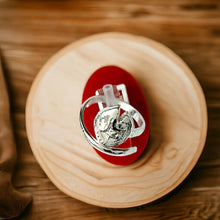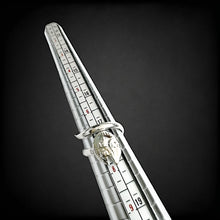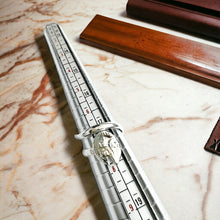The Silver God Amun Ram Head Adjustable Ring: Inspired by ancient Egyptian deity Amun-Ra, this exquisite ring symbolizes divine power and timeless elegance. Crafted with meticulous detail, it echoes the rich history and mystique of ancient Egypt, encapsulating a fusion of spirituality and style. Adjustable for a perfect fit, it invites wearers to embrace their inner deity with every wear.
- History: Inspired by ancient Egyptian culture, symbolizing power and divinity.
- Spiritually: Represents Amun-Ra, the god of creation and the sun, invoking strength and protection.
- Talisman: Thought to bring luck, prosperity, and spiritual guidance.
- Handmade: Crafted with care, each detail reflects artisanal skill and dedication.
- Healing: Associated with clarity of mind, spiritual awakening, and emotional balance.
- Material: Made of sterling silver, symbolizing purity and resilience.
- Symbolism: Amun-Ra's head signifies leadership, authority, and divine energy.
- How to wear: Adjust the ring to fit comfortably on any finger, carry its energy throughout the day.
History Side For Those Who Are Interested
Amun, one of ancient Egypt's most prominent deities, is often depicted as a man wearing a tall plumed crown, occasionally with a ram's head or adorned with ram horns. This amalgamation is referred to as Amun-Ra, a syncretic deity that combines aspects of Amun, the god of air and wind, with Ra, the sun god and supreme deity of Egyptian mythology. The ram's head symbolism associated with Amun-Ra represents fertility, strength, and leadership.
The history of Amun traces back to the Old Kingdom period (circa 2686–2181 BCE), where he was initially a local deity worshipped in the region of Thebes, known as Waset in ancient Egyptian. At this time, Amun was regarded as a relatively minor god associated with fertility and the annual flooding of the Nile River, which was crucial for agricultural prosperity in Egypt.
However, Amun's significance grew steadily over the centuries, particularly during the Middle Kingdom (circa 2055–1650 BCE) and the New Kingdom (circa 1550–1070 BCE). During the Middle Kingdom, Thebes emerged as a prominent political and religious center, and Amun's cult gained prominence alongside the rise of the city. The Theban rulers elevated Amun's status, often portraying themselves as his chosen representatives on earth.
The apex of Amun's influence came during the New Kingdom, particularly under the rule of pharaohs such as Hatshepsut, Thutmose III, and Ramesses II. Amun became associated with kingship and was increasingly depicted as a powerful and authoritative deity. The pharaohs actively promoted Amun's worship and the grandeur of his temples, most notably the Karnak Temple complex in Thebes, which became one of the largest religious structures in the ancient world.
During this period, Amun underwent a significant syncretism with Ra, the solar deity. This fusion resulted in the creation of Amun-Ra, a god who embodied the creative force of the sun and the hidden, unseen power of the air. As Amun-Ra, he was believed to manifest in the sun's disk, symbolizing both the physical and metaphysical aspects of existence.
The Ram-headed depiction of Amun-Ra emerged as a symbolic representation of his sovereignty and strength. The ram was revered in ancient Egypt for its virility, endurance, and protective qualities, all of which were attributes associated with the divine king. By incorporating the ram's head into Amun's iconography, worshippers emphasized his role as a potent and formidable deity.
The worship of Amun continued into the Late Period (circa 664–332 BCE) and even persisted through the Ptolemaic and Roman periods, albeit in a diminished form. However, with the rise of Christianity in Egypt, the cult of Amun gradually declined, and his temples fell into disrepair.
Despite the eventual decline of his worship, Amun remains one of the most enduring symbols of ancient Egyptian religion and power. His association with kingship, fertility, and the sun ensured his enduring legacy in the annals of Egyptian mythology and history.








